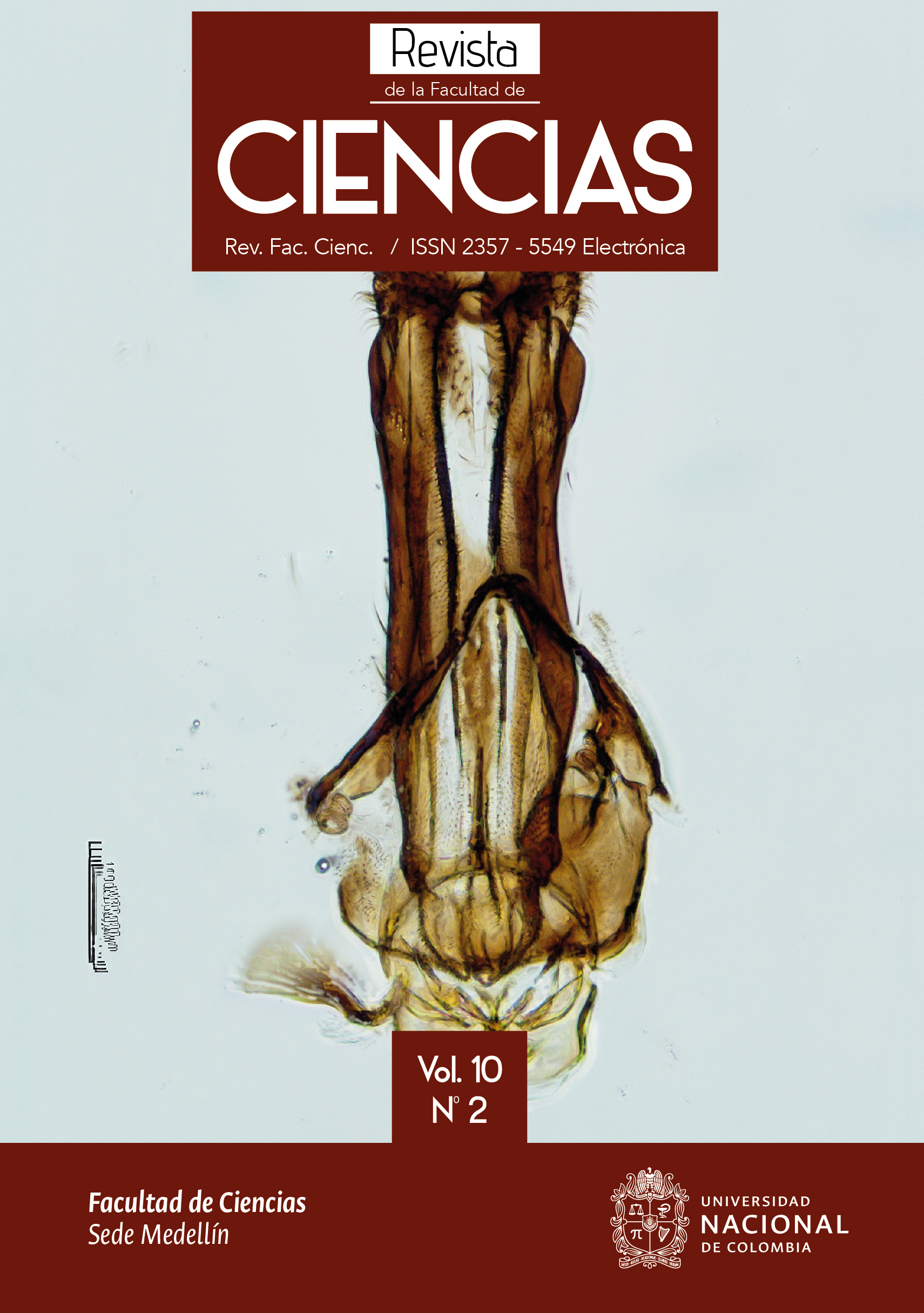CÓDIGOS DE BARRA DE ADN PARA IDENTIFICACIÓN DE ESPECIES DEL GÉNERO Lonchaea FALLEN 1820 (DIPTERA: Lonchaeidae) de Antioquia
DNA BARCODING FOR IDENTIFICATION OF SPECIES OF THE GENUS Lonchaea FALLEN, 1820 (DIPTERA: Lonchaeidae) OF ANTIOQUIA
DOI:
https://doi.org/10.15446/rev.fac.cienc.v10n2.94053Palabras clave:
Códigos de barras de ADN, Lonchaea, Taxonomía (es)Barcode, Lonchaea, Taxonomy (en)
Descargas
Lonchaea es el género con mayor número de especies y distribución dentro de la familia Lonchaeidae. Normalmente los individuos de esta familia son confundidos con los de la familia de Tephritidae cuando se encuentran afectando frutos. Los pocos estudios taxonómicos que existen sobre el género hacen que la identificación de especies sea realmente difícil, especialmente con base en las hembras ya que todas las claves existentes Lonchaea es el género con mayor número de especies y distribución dentro de la familia Lonchaeidae. Los individuos de esta familia son confundidos con los de la familia Tephritidae y ambos se encuentran afectando frutos. Los pocos estudios taxonómicos sobre el género hacen que la identificación de las especies sea difícil, especialmente con base en las hembras, colectadas más frecuentemente, ya que todas las claves existentes están basadas en la morfología de los machos. Se asignaron las secuencias código de barras de ADN para especímenes del género previamente identificados por morfología y verificados por especialistas, logrando mediante la agrupación en M-OTUs (Unidades Taxonómicas Operativas Moleculares) la asociación de genotipos machos-hembras, proporcionando información molecular valiosa como apoyo para identificar individuos de ambos sexos, e incluso inmaduros colectados en campo o especímenes presentes en colecciones entomológicas.
Lonchaea is the genus with the largest number of species and distribution within the Lonchaeidae family. Normally the individuals of this family are confused with those of the Tephritidae family when they are affecting fruits. The few taxonomic studies that exist on the genus make species identification really difficult, especially based on females since all the existing keys are based on males. The relationship between morphological and molecular variability was analyzed for specimens of the genus Lonchaea, considering an initial identification of the species based on the morphology of the males. Using the DNA barcode methodology, it was possible to assign female specimens that are difficult to identify by morphology to haplogroups or M-OTUs (Molecular Operational Taxonomic Units) in which they were grouped with previously identified male individuals and with species assignment verified by a specialist.
Referencias
Altschul, S. F. (2005). BLAST Algorithm. Encyclopedia of Life Sciences, 1–4. https://doi.org/10.1038/npg.els.0005253.
Avise, J. C. (2000). Cladists in Wonderland. Evolution, 54(5), 1828–1832. https://doi.org/10.1111/j.0014-3820.2000.tb00728.x.
Chacón, P. (1984). Entomofauna asociada a Passiflora mollissima, P. edulis, P. flavicarpa y P. quadrangularis en el departamento del Valle del Cauca. Turrialba 34: 297-311
Edgar, R. C. (2004). MUSCLE: Multiple sequence alignment with high accuracy and high throughput. Nucleic Acids Research, 32(5), 1792–1797. https://doi.org/10.1093/nar/gkh340
Felsenstein, J. (1985). Confidence Limits on Phylogenies: An Approach Using the Bootstrap Author (s): Joseph Felsenstein Stable URL: http://www.jstor.org/stable/2408678. Evolution, 39(4), 783–791. DOI: https://doi.org/10.1111/j.1558-5646.1985.tb00420.x
Folmer O, Black M, Hoeh W, Lutz R, Vrijenhoek R. 1994. DNA primers for amplification of mitochondrial cytochrome c oxidase subunit I from diverse metazoan invertebrates. Mol Marine Biol Biotechnol. 3(5):294–299.
Hébert, P. D. N., Ratnasingham, S., & DeWaard, J. R. (2003). Barcoding animal life: Cytochrome c oxidase subunit 1 divergences among closely related species. Proceedings of the Royal Society B: Biological Sciences, 270(SUPPL. 1). https://doi.org/10.1098/rsbl.2003.0025.
ICA, 2011. Resoluciones fitosanitarias. Recuperado el 30 de noviembre de 2011. En
http://www.ica.gov.co/Normatividad/Normas-Ica/Resoluciones.aspx.
Jukes TH & Cantor CR (1969) Evolución de moléculas de proteínas. En Munro HN, editor, Mammalian Protein Metabolism, págs. 21-132, Academic Press, Nueva York. DOI: https://doi.org/10.1016/B978-1-4832-3211-9.50009-7
Kimura, M. (1980). A simple method for estimating evolutionary rates of base substitutions through comparative studies of nucleotide sequences. Journal of Molecular Evolution, 16(2), 111–120. https://doi.org/10.1007/BF01731581.
Korytkowski, C. A., & Ojeda, D. (1971). Revisión De Las Especies De La Familia Lonchaeidae En El Perú (Diptera: Acalyptratae). Revista Peruana de Entomología, 14(1), 87-116. https://doi.org/10.1017/CBO9781107415324.004.
Kumar, S., Stecher, G., Li, M., Knyaz, C., & Tamura, K. (2018). MEGA X: Molecular evolutionary genetics analysis across computing platforms. Molecular Biology and Evolution, 35(6), 1547–1549. https://doi.org/10.1093/molbev/msy096.
Kunprom, C., & Pramual, P. (2019). DNA barcoding of fruit flies (Diptera: Tephritidae) in Thailand: Ambiguity, misidentification and cryptic diversity. Mitochondrial DNA Part A: DNA Mapping, Sequencing, and Analysis, 30(8), 861–873. https://doi.org/10.1080/24701394.2019.1693550.
Lanteri, A. (2007). Código de barras del ADN y sus posibles aplicaciones en el campo de la Entomología. Revista de la Sociedad Entomológica Argentina, 66, 15-25.
Luna, G. I. (1987). Clave taxonómica para la identificación del género Lonchaea Fallen en la región neotropical (Lonchaeidae: Diptera). Universidad de Panamá.
MacGowan, I., & Rotheray, G. E. (2019). Lonchaeidae. En Manual of Afrotropical Diptera. Vol. 3 (pp. 1383-1392).
Medina, J., & Takumasa, K. (2012). Listado taxonómico de organismos que afectan la pitaya amarilla, Selenicereus megalanthus (K. Schum. Ex Vaupel) Moran (Cactaceae) en Colombia. Revista Corpoica - Ciencia y Tecnología Agropecuaria. DOI: https://doi.org/10.21930/rcta.vol13_num1_art:238
Meier, R., Shiyang, K., Vaidya, G., & Ng, P. K. L. (2006). DNA barcoding and taxonomy in Diptera: A tale of high intraspecific variability and low identification success. Systematic Biology, 55(5), 715–728. https://doi.org/10.1080/10635150600969864.
Puillandre N, Lambert A, Brouillet S, Achaz G (2012) ABGD, Automatic Barcode Gap Discovery for primary species delimitation. Mol Ecol 21: 1864–1877Pennington J, Wells M. The adult Midgut Structure and Function. En: Biology of disease vectors. 2005. 2da. Ed. Marquardt Pp. 785. DOI: https://doi.org/10.1111/j.1365-294X.2011.05239.x
Rozas, J., Ferrer-Mata, A., Sánchez-DelBarrio, JC, Guirao-Rico, S., Librado, P., Ramos-Onsins, SE, Sánchez-Gracia, A. (2017). DnaSP 6: Análisis de polimorfismo de secuencia de ADN de grandes conjuntos de datos. Mol. Biol. Evol. 34: 3299-3302. DOI: 10.1093 / molbev / msx248 DOI: https://doi.org/10.1093/molbev/msx248
Saitou, N., & Nei, M. (1987). The neighbor-joining method: A new method for reconstructing phylogenetic trees. Molecular biology and evolution, 4(4), 406–425. https://doi.org/10.1093/oxfordjournals.molbev.a040454.
Song, H., Buhay, J. E., Whiting, M. F., & Crandall, K. A. (2008). Many species in one: DNA barcoding overestimates the number of species when nuclear mitochondrial pseudogenes are coamplified. Proceedings of the National Academy of Sciences of the United States of America, 105(36), 13486–13491. https://doi.org/10.1073/pnas.0803076105
The International Barcode of Life Consortium (2016). International Barcode of Life project (iBOL) Barcode Index Numbers (BINs). Checklist dataset https://doi.org/10.15468/wvfqoi accessed via GBIF.org on 2021-07-09.
Cómo citar
APA
ACM
ACS
ABNT
Chicago
Harvard
IEEE
MLA
Turabian
Vancouver
Descargar cita
CrossRef Cited-by
1. Braulio Alberto Lemus-Soriano, Oscar Morales-Galván, David García-Gallegos, Diana Vely García-Banderas, Mona Kassem, Carlos Patricio Illescas-Riquelme. (2025). Neosilba batesi Curran (Diptera: Lonchaeidae): Identification, Distribution, and Its Relationship with Avocado Fruits. Diversity, 17(7), p.499. https://doi.org/10.3390/d17070499.
2. Rodrigo Lasa, Laura Navarro-de-la-Fuente, Iain MacGowan, Trevor Williams. (2025). Avocado Sustains a Complex of Neosilba spp. (Diptera: Lonchaeidae) in Veracruz, Mexico. Agronomy, 15(11), p.2476. https://doi.org/10.3390/agronomy15112476.
Dimensions
PlumX
Visitas a la página del resumen del artículo
Descargas
Licencia

Esta obra está bajo una licencia internacional Creative Commons Atribución-NoComercial-SinDerivadas 4.0.
Los autores o titulares del derecho de autor de cada artículo confieren a la Revista de la Facultad de Ciencias de la Universidad Nacional de Colombia una autorización no exclusiva, limitada y gratuita sobre el artículo que una vez evaluado y aprobado se envía para su posterior publicación ajustándose a las siguientes características:
1. Se remite la versión corregida de acuerdo con las sugerencias de los evaluadores y se aclara que el artículo mencionado se trata de un documento inédito sobre el que se tienen los derechos que se autorizan y se asume total responsabilidad por el contenido de su obra ante la Revista de la Facultad de Ciencias, la Universidad Nacional de Colombia y ante terceros.
2. La autorización conferida a la revista estará vigente a partir de la fecha en que se incluye en el volumen y número respectivo de la Revista de la Facultad de Ciencias en el Sistema Open Journal Systems y en la página principal de la revista (https://revistas.unal.edu.co/index.php/rfc/index), así como en las diferentes bases e índices de datos en que se encuentra indexada la publicación.
3. Los autores autorizan a la Revista de la Facultad de Ciencias de la Universidad Nacional de Colombia para publicar el documento en el formato en que sea requerido (impreso, digital, electrónico o cualquier otro conocido o por conocer) y autorizan a la Revista de la Facultad de Ciencias para incluir la obra en los índices y buscadores que estimen necesarios para promover su difusión.
4. Los autores aceptan que la autorización se hace a título gratuito, por lo tanto renuncian a recibir emolumento alguno por la publicación, distribución, comunicación pública y cualquier otro uso que se haga en los términos de la presente autorización.
5. Todos los contenidos de la Revista de la Facultad de Ciencias, están publicados bajo la Licencia Creative Commons Atribución – No comercial – Sin Derivar 4.0.
MODELO DE CARTA DE PRESENTACIÓN y CESIÓN DE DERECHOS DE AUTOR





















